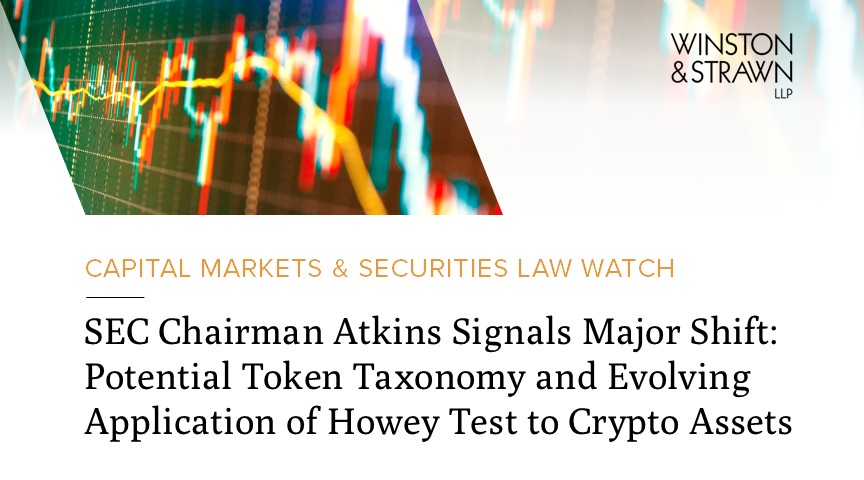In a speech on November 12, 2025 at the Federal Reserve Bank of Philadelphia, Securities and Exchange Commission (SEC or Commission) Chairman Paul S. Atkins outlined the next phase of the SEC’s “Project Crypto,” advocating for clarity and fairness in the regulation of digital assets. The speech implicitly criticized the SEC’s approach to crypto regulation during the Gensler era, suggesting that it created unnecessary barriers to American innovation in the sector. Chairman Atkins, building on the seminal work of SEC Commissioner Hester Peirce, provided an overview of a potential symbolic taxonomy based on SEC v. WJ Howey Co.328 US 293 (1946), which could classify many crypto assets as non-securities, potentially providing the regulatory clarity the industry has long sought.
The SEC’s new approach aligns with Congress’s push for comprehensive crypto legislation and signals that many digital assets, including those previously targeted by the SEC’s enforcement actions, could escape the agency’s jurisdiction, in the view of the current Commission. Below, we explore key takeaways from Chairman Atkins’ remarks and their implications for the digital asset landscape.
A proposed taxonomy of tokens: categories and challenges
Chairman Atkins emphasized the need for “consistent and transparent treatment of crypto assets under the federal securities laws” and signaled a shift away from past presumptions that treated most tokens as securities. He presented a non-exhaustive taxonomy comprising four categories that broadly correspond to how industry players perceive different crypto instruments:
- Digital Products or Network Tokens: No titles; these derive value from functional, decentralized systems rather than expectations of profit from the management efforts of others.
- Digital Collectibles: No titles; these encompass NFTs or tokens representing artwork, music, videos or gaming items, for which buyers do not have expectations of profit tied to the issuers’ efforts. This is a key acknowledgment by the SEC, as the SEC had previously taken enforcement action against certain art-related NFTs.
- Digital tools: No titles; these serve practical purposes like membership, tickets, credentials or ID badges, and there is no expectation of profit.
- Tokenized securities: Remaining titles; these represent traditional financial instruments (e.g. stocks or bonds) on blockchain networks.
This new framework claims to prioritize economic substance over form and represents a step forward for the digital assets sector. However, developing a comprehensive taxonomy for crypto assets will still present challenges. The digital asset space features near-infinite variety and rapid innovation, with inevitable gray areas. As the Commission advances this project, it will be essential to balance flexibility and clarity to adapt to changing technologies without stifling growth.
Reinterpretation Howey: When investment contracts end
At the heart of President Atkins’ speech is the application to digital assets of Howey test: whether there is an investment in a joint enterprise with expected benefits from the efforts of others. Chairman Atkins asserted that non-security tokens may initially be sold under investment contracts (which constitute securities) during a fundraise, but that these contracts may expire as networks mature, code is deployed, and the role of issuers fades, causing the tokens themselves to no longer be securities under the Howey test.
He highlighted the role of “explicit and unambiguous” representations or promises of managerial efforts. Once fulfilled, failed or terminated, the investment contract terminates, allowing the token to trade without being securities subject to regulation as such. Make an analogy with citrus groves (the original subject of Howey) moving toward non-security uses like golf courses, a view echoed by Commissioner Peirce and some courts, Chairman Atkins provides clearer insight into when a token may lose its security status.
Notably, Chairman Atkins directed the SEC staff to prepare recommendations on how to facilitate the trading of tokens on platforms not regulated by the SEC, including those under the Commodity Futures Trading Commission or under state supervision, with an eye to promoting innovation in the crypto industry without rigid jurisdictional boundaries.
Future Directions
If implemented, this approach could alleviate regulatory uncertainty, thereby enabling innovation in the United States and reducing the migration of new technologies and instruments abroad. Stakeholders should evaluate their assets in light of this new framework and monitor formal rulemaking by the SEC in the near future.
Winston’s Capital Markets and Securities Law Watch will continue to monitor developments and provide our readers with additional updates as they become available. For more information or if you have any questions, please contact the authors of this blog post or your usual Winston contacts.




